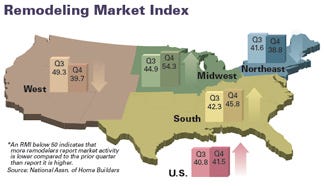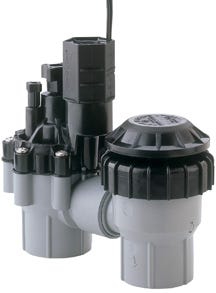Market Snapshot: Home & garden
The housing market remains sluggish and home prices continue to fall, but it’s not all bad news. New home building is picking up a bit, and many homeowners have decided to stay put and use this economic environment to remodel, refresh, and revive their homes.
March 2, 2011
The housing market remains sluggish and home prices continue to fall, but it’s not all bad news. New home building is picking up a bit, and many homeowners have decided to stay put and use this economic environment to remodel, refresh, and revive their homes.
The December 2010 Commerce Dept. report on new housing sales provided some signs of hope for homebuilders. Sales of new single-family houses in December were at a seasonally adjusted annual rate of 329,000, according to estimates released jointly on Jan. 26 by the U.S. Census Bureau and the Dept. of Housing & Urban Development. This is 17.5% above the revised November rate of 280,000, but 17.0% below the December 2009 estimate of 356,000.
“After six very tough months, the housing market ended the year on an upbeat note, with signs of stabilization beginning to take hold in many markets,” says Bob Nielsen, chairman of the National Assn. of Home Builders (NAHB) and a homebuilder from Reno, NV. “That said, the nationwide inventory of new homes for sale is now at its thinnest level in more than 40 years. This is a sign that many builders still cannot obtain the credit they need to meet anticipated improvements in buyer demand in 2011.”
|
The average sales price of new houses sold in December 2010 was $291,400. An estimated 321,000 new homes were sold in 2010, which was 14.2% below the 2009 figure of 375,000.
For remodelers, the NAHB’s Remodeling Market Index (RMI) edged up to 41.5 in Q4 2010, compared to 40.8 in Q3. An RMI below 50 indicates that more remodelers say the market is lower compared to the prior quarter than report it is higher. The RMI has been running below 50 since Q4 2005.
“Remodeling activity has been rising slowly since the first quarter of 2010. Expected improvements in the job market and the overall economy are beginning to increase homeowners’ confidence and remodelers are seeing indications that business will pick up,” says David Crowe, chief economist for the NAHB.
Molded polymer shakes and shingles catching on
Polymer materials are not new to the homebuilding industry, as conventional extruded vinyl siding has been around for nearly three decades. However, injection molded roofing materials, fairly new to the market, are being readily accepted by the industry. Ray Rosewell, president of DaVinci Roofscapes (Kansas City, KS), says that polymers are generally accepted by builders and architects today because they are used in so many different areas on a home’s exterior.
“It’s not a big issue anymore in having to sell the idea that polymers are the right materials for building applications,” he notes. “Some acceptance problems exist in areas where there was an alternative material that didn’t hold up well in certain climates or under certain conditions or applications, and it created problems. That’s why we moved away from the term synthetic, and call our product polymer.
“People are familiar with polymer building materials with products like Trex decking, vinyl windows, and extruded trim products, and the fact that these products don’t fade and are low-maintenance,” Rosewell continues. “There are so many positives to polymer products that people not only accept it, but actually seek it out.”
DaVinci molds its own products, including its Bellaforté and Valoré polymer slate. Rosewell explains that DaVinci Roofscapes increased its capacity by 20% last year to meet demand for the company’s products, including adding equipment and bringing on two new stack molds. DaVinci subs out the mold manufacturing, but does its own compounding of materials with color, UV, and FR additives, and has developed a process technology that allows workers to change from one color to another inline.
At this year’s International Builders Show, DaVinci Roofscapes introduced a variety of new colors to its product lineup. “People are becoming more discerning with respect to color,” says Rosewell. “There’s always been a lot of emphasis on interior color, but we see more people looking toward exterior color as outdoor living space becomes the norm. The alternative polymer products offer that.”
Lawn and garden
Curb appeal is a big deal, and products for lawn and garden continue to be a hit with consumers. What consumers want are products that help conserve water, and make lawn/garden care easier and less time consuming. The U.S. is the dominant producer of lawn and garden equipment, with 2008 shipments of $9 billion and exports of nearly $500 million. The residential market accounted for 60% of power lawn and garden equipment, according to The Freedonia Group, a Cleveland, OH-based industrial market research firm.
Scotts Miracle-Gro Co. (Marysville, OH) is the largest U.S. supplier of lawn and garden products. The company reported fiscal Q1 sales of $230.2 million for the period ending Jan. 1, 2011. Consumer activity in lawn renovation projects was up 75%, led by a 90% increase in consumer grass seed purchases, a 50% increase in Turf Builder Starter lawn fertilizer, and more than a 30% increase in lawn soils.
All of this activity in growing green, lush lawns inevitably leads to lawn mowing, and naturally lawnmowers represent the largest product segment in this market. The Toro Co. (Bloomington, MN) had fiscal 2010 (ended Oct. 31, 2010) net earnings of $92.3 million. Quarterly sales increased 17%, and sales for the year grew 11% to $1.7 billion, with double-digit growth in both professional and residential segments. Michael J. Hoffman, chairman and CEO of Toro, says the results reflect “a return to change in the right direction.”
The company’s 2010 activities included building a new manufacturing facility in Eastern Europe to serve increasing agricultural demands in that region. On Jan. 17, 2011, Toro announced it had acquired certain assets from Unique Lighting Systems (Escondido, CA), a manufacturer of professionally installed landscape lighting fixtures and transformers for residential and commercial use. The acquisition will be with Toro’s irrigation business in Riverside, CA.
Irrigation is a critical component of the lawn and garden market, and homeowners are seeking water conservation measures. Azusa, CA-based Rain Bird, a privately held manufacturer of professional and residential irrigation/sprinkler systems, introduced new weather-based landscape watering technology gadgets to help homeowners reduce water waste. These products range from weather-based “smart controllers that adjust sprinkler operation according to current and historical weather data” to wireless rain and freeze sensors and moisture sensors that deliver real-time information on soil condition. Each of these new products is designed to be used in residential lawns and gardens, and can help homeowners cut outdoor water use by up to 70%.
Ames True Temper makes a variety of molded lawn and garden products such as its ReelEasy hose reels. These include the ReelEasy Bench-style, a deck-style hose reel with a swivel base, and a large-capacity ReelEasy Designer Series polymer hose reel in a “wrought-iron design” that holds up to 225 ft of 5/8-inch-diameter hose. In September 2010, Griffon Corp., a diversified management and holding company, bought Ames True Temper, Clopay Building Products, and Clopay Plastics Products.
Marketing to the 
right audience
The use of polymer materials in home building is becoming increasingly more prevalent. As consumers read about these alternative products and their benefits over traditional building materials, they are accepting them.
DaVinci’s Rosewell says his company markets to architects, builders, and homeowners. “With respect to replacement roofs, the homeowners are a definite target for us,” he says. “Just as important, however, is marketing to the roofing contractors. They are the gatekeepers, because they will be the people to sit down with the homeowner to talk about the roof. The homeowner can say, ‘I read about this product,’ but if a contractor doesn’t know about it or if he has a negative perception of the product, he can undo the sale.”
To help with acceptance among contractors, many manufacturers of alternative building products make installation of the new products as much like the installation of the traditional building product as they can. “We work hard with the contractors through our loyalty program, and we recruit them and make them aware of the products’ advantages, and provide training to contractors in installation techniques,” adds Rosewell. “With new homes, architects, homeowners, builders, and roofing consultants all influence the decision making, and we market our message to all of those audiences.” —Clare Goldsberry
About the Author(s)
You May Also Like






